Clicking on most pictures will show a larger version
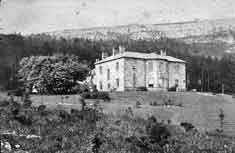
Malham Tarn House (circa 1857)
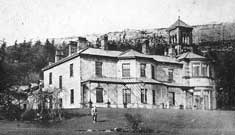
The house after remodelling by Morrison
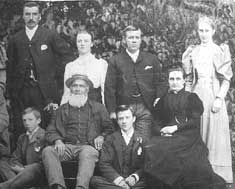
Walter Morrison and his domestic staff (1890s): (L-R back) Alfred & Ellen Ward (gamekeeper), William & Martha Skirrow (butler)
(Front) ?, Walter Morrison, ?, Miss Lodge (housekeeper)
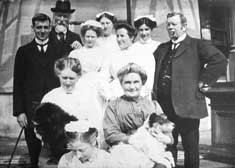
Malham Tarn House staff early 1900s (named)
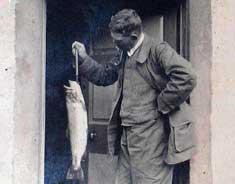
Thomas Brayshaw with a Malham Tarn trout
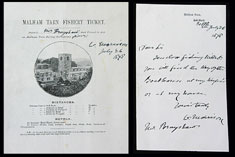
Mr Brayshaw's fishing ticket
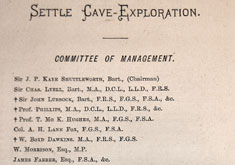
Settle Cave Exploration Society- commitee
member

Signatures on the wall of Robinson's Pot, Darnbrook, Malham Moor
Walter Morrison
"A man of many parts"
Local Squire
In 1852 Lord Ribblesdale sold the Malham estate to James Morrison and Walter inherited it in 1857 when he was 21. He proceeded to extend Malham Tarn House by adding the east wing, the verandah and the Italianate bell tower (dismantled about 1963) which was similar to the tower at Fonthill. He also renewed much of the interior.
In 1873 a terrible fire occurred which left little more than the outer shell, but fortunately the books and pictures were rescued. Re-building began almost immediately. Even when it was completed the house furnishings were sparse and the place uncomfortable by most standards, but it had large rooms, big windows, beautiful views and peace and tranquillity.
Morrison’s house and estate were in good hands. William Skirrow was the butler at the London house in Cromwell Road and at Malham when needed and Martha, his wife, was the housekeeper in London. Miss Bella Lodge was the housekeeper at Malham and it was said that she acted like a lady when the master was away. Robert Battersby was the coachman and just before the First World War when a car was purchased, it was he who became the chauffeur. Although he was 75 at the time he was sent for driving lessons and after three circuits round Settle, he was pronounced fit to drive. It was said that when he arrived back at the yard with the new car he shouted ‘Whooa, lass, whooa.’ But the car did not stop. It crashed into a gatepost and smashed one of the lamps!
John Greenwood and later John Petyt cared for the gardens, helped by Dickie Bates and Ted Banks. John Petyt walked from Arncliffe and the rest from Malham daily. Alfred Ward was the gamekeeper helped by his son and later Mr Usher. The estate generally was in the hands of the agent, John Whittingale Winskill, a smart dapper man who dealt with the estate more or less single handed. He was in charge of the shooting and fishing on the estate. Morrison was a reasonable shot but not particularly interested in the sport although the annual grouse bag was usually well over 1000. When shooting parties were arranged guests were expected to turn out whatever the weather and he is reputed to have locked up the billiard balls if the weather was bad so there was no escaping the pouring rain.
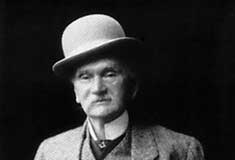
John Whittingale Winskill
Besides the shooting parties and luncheons there was an endless stream of groups visiting Tarn House. There were Boy Scouts, fishermen, archaeological societies, geological groups, children’s galas to name but a few. Haworth Ramblers came on one occasion and according to Geoffrey Dawson, his neighbour from the Langcliffe estate, his speeches on these occasions could be quite above their heads as he seemed unable to adapt to the differing groups of people.
As well as the endless groups there were the private visitors who stayed at the house. Among these Charles Kingsley is probably the best known and his letters from Tarn House still exist. He was delighted with the area and its inhabitants and wrote, ‘The people are the finest I ever saw – tall, noble, laconic, often handsome. Very musical too, the women with the sweetest voices in speech which I have ever heard.’ Malham Cove impressed him with its dark markings which he used in The Water Babies. He also found the fishing in the Tarn ‘the best in the whole earth.’ Other famous visitors included Thomas Hughes, author of Tom Brown’s Schooldays, Darwin, John Stuart Mill and John Ruskin, who stayed in Malham at the Buck Inn and painted a watercolour of Middle House Farm on the estate.
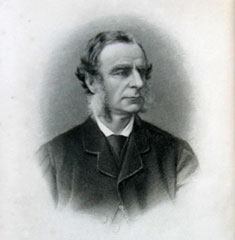
Charles Kingsley (1819-1875)
Tarn House was Walter Morrison’s home for over sixty years and he was interested in every part of the estate and every family who lived there. Margaret Thompson’s great-grandfather Stephen Carr, was a tenant farmer of Walter Morrison, first at Park House and then at Lee Gate. Walter Morrison had a habit of visiting his tenants unannounced, which although his motives were kindly, had the effect of causing some panic at the farm. These were the days when tenants ‘knew their place in society’. When these visits occurred the older children melted into the background and Mr Morrison invariably sat with the toddler on his knee, preferring the toddlers to the small babies. After the birth of one of her ten children when Mrs Carr was proudly displaying her new daughter, Mr Morrison said ‘Oh what a shame. Better luck next time’, a comment which would hardly endear him to the proud mother!
On another visit Mrs Carr was baking, making pastry, when the landlord arrived unannounced and told her to carry on and he would just sit and be as quiet as a mouse. No doubt Mrs Carr was all fingers and thumbs being watched while she went about her work. When she had finally finished he commented that he had always wanted to know how the jam got into jam pasties!
He built several new houses on the estate and rebuilt others using an architect from London. They were all built to the same style with steep roofs and can be picked out as ‘Morrison’ houses. Middle House was rebuilt, and also the Buck Inn at Malham. One farmer mentioning to Morrison that he could not see out of the window in his new house when he was sitting down was told ‘a farmer should get up and go out, not sit and look out’.
Morrison was a great walker and would be seen striding around the estate and up the hill from Settle. On Sundays all the household staff went to St Michael's church in Kirkby Malham. The staff walked down but were allowed to ride back although Morrison preferred to walk. It was said that he would sometimes have a helping hand by holding on to the horse’s tail on the uphill road.
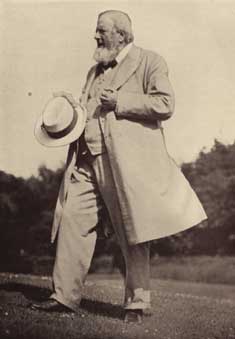
Walter Morrison
Although wealthy he was very careful with money and inspected all the estate accounts. When a sheep died it was debited from the accounts but the fleece had to be credited.
His interest spread to all parts of the area and his name can be found as a subscriber to many different groups in the district. For example he was a member of the Settle Cave Exploration Society after Victoria Cave had been discovered in 1869. In 1975 an amazing discovery was made. A hole found under a flagstone by the kitchen window at Darnbrook Farm proved to be a pothole a mile long. Exploration of this by David Hodgson led to a chamber where seven names and dates were scratched on the wall. Amongst them was W Morrison 1867 – he had been there over 100 years before!
It is impossible to mention all the organisations with which he had a connection, but although business and parliamentary duties took him away from the estate a great deal, he was in no way an absentee landlord and liked nothing better than to return to his ‘mountain home’ as often as he was able.